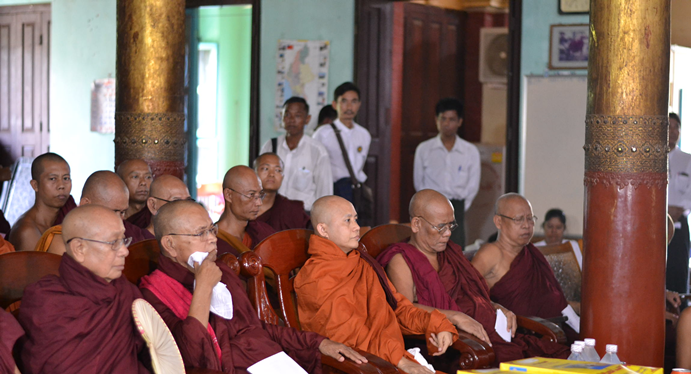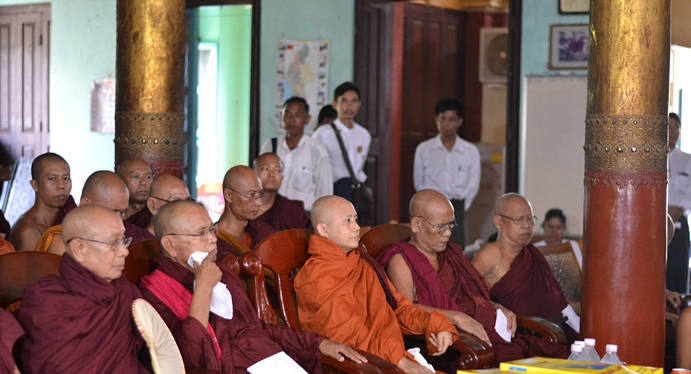“Muslims are pitiable, stupid and ignorant. They are not living in harmony with us.”
U Wirathu, a leader of the ultra-nationalist and anti-Islamic 969 movement, made this statement at a press conference at Mandalay’s Mogaung Monastery on Sunday 6 July 2014. His message to Muslims was simple: they don’t belong in Myanmar.
As Buddhist nationalists continue to ‘protect’ Buddhism, sectarian clashes indicate the ongoing process of political reforms may be more fragile that they outwardly appear. It is clear that the country’s military-dominated system now needs to factor in the disparate — and often contradictory — political aims of various powerful interests: isolationist Buddhist nationalism, and those that want to see Myanmar forge broad links with the outside world after six decades of weak links internationally.
With the end of internet censorship in 2012, social media has become an important platform for the dissemination of information. To this end, Facebook has exacerbated Myanmar’s culture of rumour and speculation, which stems from the unreliability of official channels during military rule.
Recently, Mandalay was shaken by religious conflict between Buddhists and Muslims, incited through rumour-mongering on blogs and Facebook. A Buddhist woman was allegedly raped. A Buddhist man was murdered. A Muslim man was murdered. A state-of-emergency, put in place on Thursday 3 July 2014, forced Mandalay’s residents indoors between 9 pm and 5 am. As violent incidents continued, Wirathu said “it is up to Buddhists to stop such trivial issues from escalating into sectarian clashes” – a statement that implies blame for the riots lies with the city’s Muslim population.
At the press conference in Mandalay, Thein Win Aung, a Muslim and the Secretary-General of the interfaith association in Mandalay, rose from the audience. He took the microphone between both hands and made an emotional appeal for the protection of Muslims due to their minority status, saying “Our association is helpless without the support of our respectable elderly monks.” Muslims were badly outnumbered at the press conference-cum-sermon: amidst a crowd of some 400 Buddhists in front of a 50-strong panel of monks, he called out: “We find ourselves being taken hostage.”
On 5 July 2014, I spoke with three Muslim men in Mandalay. They were close friends with Soe Min, a Muslim man who was killed in the early morning of 2 July, as he cycled to a local mosque for pre-dawn prayers. His death was so brutal that nobody knew who he was until his wife turned up at the scene. I met Soe Min and his friends in March at an interfaith dialogue in Mandalay. The 51-year-old second-hand bicycle dealer was a gentle man and a volunteer social worker.
Mourning the loss of their friend during Ramadan, Soe Min’s friends were fielding several incoming telephone calls. After a call, one man lifted his eyes from the floor, and looked at me as though he had been battered. “The police sent Soe Min’s body to hospital. They reported it as a car accident victim.”
These three Muslim men no longer see the value in interfaith dialogue. “Interfaith can’t do much if it doesn’t draw attention from the public,” they said. “[Myanmar needs to] teach multiculturalism in primary school, so kids can learn about others. The country has been closed from the outside world for so long, that people haven’t had exposure to others.”
I asked the three men if they feared for their safety. “Everyone is scared. We even have Buddhist friends calling us to stay with them. No one knows when this will stop. We are so disappointed with the government,” one of the men said. While formal channels for interfaith dialogue exist in Mandalay, they claimed such activities are “no more than a show for the international community – that the government is doing something [in the background]”.
“The government must be behind this”, they tell me. “They could have done something, but they didn’t. They have all the information. If they want to prevent these incidents they can. Intentionally, they let it happen.”
The Mandalay incident has striking similarities with other recent outbreaks of violence in Myanmar, such asMeitkila and Lashio last year. All three cases were well-organised, and mobs have razed Muslim targets as they wield swords and ride motorcycles.
The three Muslim men compared the current state of affairs to the crackdown during the ‘Saffron Revolution’ of 2007, where the government stopped monks protesting almost immediately. “In this case [Mandalay] it’s the complete opposite,” they said. “Monks rose against the government then, and they [the government] stopped it.”
Competing narratives in Mandalay are playing out between Musilms, Buddhists and the authorities. Muslims say they have been “taken hostage” – that the government is fuelling sectarian conflict. According to Soe Min’s friends, the police have “stood by and [done] nothing”.
I spoke with two monks at Mandalay’s Yankin Hill, U Uttama and U Nyaninda. They believe “the police are protecting the Muslims”, said U Nyaninda. To justify the actions of Buddhists, he told me “when police officers work for Muslims, Buddhists are angry. Buddhists have to fight back.”
U Nyaninda believes Islam poses a fundamental threat to Burmese Buddhism. “Islam is a threat, everywhere. All over the world,” he says. “They [Muslims] want to distribute their people, their economies, and violence. We don’t know their secrets every Friday at the mosque. Out of that loud speaker, they’re talking in Arabic “you must kill!”.
Competing narratives centre around the establishment of that narrative — different groups want their version of events to be accepted as the canonical truth. The power of rumor is a tool that reinforces the power of religious — primarily Buddhist — elites in Myanmar. The most prominent — and powerful — example of is the MaBaTha, or the Committee for the Protection of Race and Religion, lead by prominent nationalist monks including Wirathu.
While the Sangha (Myanmar’s community of Buddhist monks, or Buddhist clergy) has always played a role in politics, monks have taken on an explicit political role over the past year or two. The MaBaTha has taken the unprecedented step of proposing legislation to the government. Elements within the Sangha are seeking to re-envision the traditional balance of power between Myanmar’s two principal institutional clusters – the Sangha itself, and the lay instutions of the presidency, parliament and military. The most recent case has been the controversial religious conversion bill, which intends on preventing forced religious conversions. This bill is part of a package of proposed leglisation to ‘protect race and religion’.
In the Mandalay conflict, its important to consider how the quest for power has played a catalyst for conflict. There were claims that Wirathu had posted on Facebook that the city’s mosques had called for ‘jihad‘. As one analyst has noted, “the role of some members of the Sangha (Buddhist clergy) in vitriolic objectification and in some cases incitement to violence against Muslims is a stark departure from decades of the clergy’s role as a barometer of social discontent, especially during the 2007 protest against military rule.”
At the sermon, seated alongside the abbots of the city’s monasteries, Wirathu called upon Buddhists to protect their faith. “Thanks to our efforts,” he said, “you don’t see angry Buddhist monks roaming on the streets of Mandalay. If we were not here in the town, then you would see the bloodshed on the streets. We try to stop such trivial issues from escalating into sectarian clashes.”
Did the Mandalay incident occur spontaneously, or is it part of Myanmar’s broader political puzzle? What is certain, is that successive governments in Myanmar have stoked ethnic tensions in the past for political leverage, such as Ne Win’s anti-Chinese campaign in the 1960s. Considering ultra-nationalist Buddhism has enough grassroots support to sustain itself, and that the government has already taken MaBaTha’s agenda in parliament, the political puzzle is likely to remain an issue beyond the 2015 general election.
Olivia Cable is a graduate student at the ANU College of Asia and the Pacific. She is currently working as a teachers’ assistant at Yangon University, Myanmar.
 Facebook
Facebook  Twitter
Twitter  Soundcloud
Soundcloud  Youtube
Youtube  Rss
Rss 
